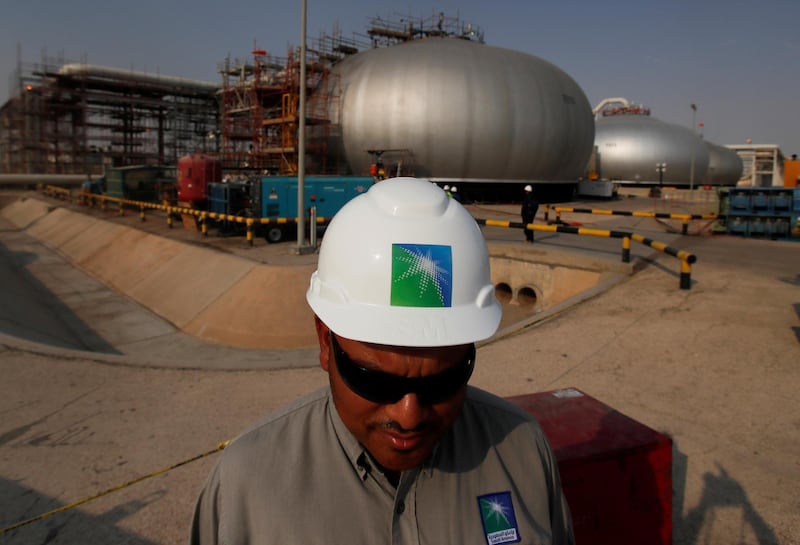Saudi Aramco, the oil and gas company that supplies one in every eight barrels of crude oil to the world, is set to float its shares on the local stock market for the first time in its 86-year history.
In putting forward the investment case for taking part in its initial public offering, the subscription period for which began on Sunday, it stated both strengths and risks facing the company as well as the oil industry at large. Whichever way you look at it, the Saudi Aramco offering could prove to be the most significant economic and financial development in the Middle East’s modern history.
Aramco is asking investors in the kingdom to join it on its journey to becoming “the world’s pre-eminent integrated energy and chemicals company". Its financial strengths are already well publicised and after its shares list on the Tadawul exchange, expected next month, it will become one of the biggest public companies in the world by market capitalisation, joining the likes of Apple, Microsoft and Google’s parent Alphabet.
The Saudi government, currently the sole shareholder, will have also opened up its most important company and sector to its people, residents and also GCC nationals as well as some of the biggest institutional names. Privatisation matters because the private sector's increased participation is critical for job creation and innovation – in this case in the energy sector. Also, the proceeds of the initial public offering, which could be in the region of $25 billion, can then be used to stimulate the non-oil economy, creating much needed opportunity for the population as well as longer-term economic growth. There has also been an increase in transparency during the offering process as a result of financial and operating disclosures.
Tied up with this is Saudi Aramco's stated position – according to its public offering prospectus – on arguably the most pressing issue of our times: the peril of climate change as outlined most recently by a study from University of Sydney in Australia. Globally, there has been much effort to tackle the earth's "climate emergency" – for example the UAE has launched the country's National Climate Change Plan 2017-2050 – but the general assessment is that we must do more and do it fast. To meet the objectives of the 2015 Paris deal, the UN has said that signatories must now cut greenhouse gas emissions by 45 per cent over the next decade and there is a longer-term goal to reach net zero emissions by 2050.
We will need more institutions, organisations and corporations to do their bit.
Perhaps Saudi Aramco’s example can help rally them to the cause. Aramco’s efforts, and almost as importantly, their public pronouncements on this topic as outlined in black and white and issued to future owners of the company could be a potential and significant boost for those working in this region to mitigate the earth’s climate emergency. Aramco is after all the world’s single largest producer of crude oil. What it thinks and does about climate change matters a great deal – and not just to the oil and gas industry but to other sectors in Saudi and across the region.
In its prospectus, Saudi Aramco clearly accepts that the impact of climate change is a genuine risk that must not be ignored by the company and its shareholders.
“Existing and future climate change concerns and impacts…could shift demand to other fuels, reduce demand for hydrocarbons and hydrocarbon-based products, have a material adverse effect on the company’s business, financial position and results of operations,” the document says.
Admittedly, the frame of reference is specific to the outlook for a company that is primarily a producer of oil and gas but it is still a powerful assessment of what the world is facing.
To meet this challenge, Aramco aims to grow its business sustainably by developing technologies and innovations to lower its climate impact, including through outside collaborative efforts. There is immense potential for any or all of these applications to help beyond just the energy industry. Achieving its objective to reduce its own climate impact will also be widely felt.
Last year, according to the document, Aramco also started a greenhouse gas emissions management programme to account for them. It has also published data that shows that direct and indirect greenhouse gas emissions from its operations for 2018 totalled 61.28 million tonnes of carbon dioxide equivalent. To give this number some sense of scale, according to the US Environment Protection Agency’s online calculator of greenhouse gas equivalencies, that is the same as the emissions created from 150 billion miles driven in a car or the annual electricity use of 10.6 million homes or 7.8 trillion smartphones charged. You would need 72 million acres of forest to remove that amount of carbon dioxide from the atmosphere or to avoid them you would need the equivalent of 12,986 wind turbines running for a year or 21 million tonnes of waste recycled instead of landfilled. While Aramco takes great care to state that external research shows that given the volume of crude it produces it is ranked as the second lowest emitter among the 50 countries, it is also underlining to investors its commitment to reduce emissions, which could prove a windfall for its new shareholders and beyond.
Mustafa Alrawi is an assistant editor-in-chief at The National





